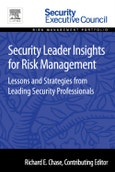How do you, as a busy security executive or manager, stay current with evolving issues, familiarize yourself with the successful practices of your peers, and transfer this information to build a knowledgeable, skilled workforce the times now demand? With Security Leader Insights for Risk Management, a collection of timeless leadership best practices featuring insights from some of the nation's most successful security practitioners, you can. This book can be used as a quick and effective resource to bring your security staff up to speed on security's role in risk management. Instead of re-inventing the wheel when faced with a new challenge, these proven practices and principles will allow you to execute with confidence knowing that your peers have done so with success. Part one looks at the risk assessment and subtopics such as compliance, using risk assessments to increase security's influence, and risk indicator dashboards. Part two discusses risk management topics such as board-level risk, global risk, risk appetite, and enterprise risk management (ERM). Security Leader Insights for Risk Management is a part of Elsevier's Security Executive Council Risk Management Portfolio, a collection of real-world solutions and "how-to" guidelines that equip executives, practitioners, and educators with proven information for successful security and risk management programs.
Please Note: This is an On Demand product, delivery may take up to 11 working days after payment has been received.
Table of Contents
Part 1: Risk Assessment1. Looking at Risk from a Different Angle to Achieve Results
Sometimes looking at a problem from a different perspective can help solve a particularly costly or significant safety threat.
2. Learning from the Past: Risk Management versus Compliance
A security professional draws a comparison with the Titanic disaster of 1912 as an example of what not to do when thinking about safety and compliance.
3. Increase Influence and Protection through Proactive Risk Assessments
Learn how to make an immediate and significant impact on business leaders with these guidelines for proactive risk assessments.
4. Security Risk Assessments: Integrating the Concept
Two experienced security professionals discuss the idea of requiring security risk assessments as part of a formal public policy.
5. The Risk-Aware Organization
Strategies for creating a more risk-aware organization include planning, preparing, training, responding, and analyzing.
6. Building a Risk Indicator Dashboard
An experienced security executive explains how a risk indicator dashboard can be a highly effective tool for communicating risk to upper management.
Part 2: Risk Management
7. Managing Board-Level Risk
Two security practitioners measure the impact of corporate risk oversight on the security function and discuss how security must adapt to the oversight-management cycle.
8. Confronting Global Risk
Think about how to manage evolving hazards global business security leaders face with these ideas for sharing knowledge.
9. What Is Your Risk Appetite?
Learn how to define your risk appetite, or your willingness to incur risk for a return, with these strategies for balancing security with the needs of the business.
10. Is Enterprise Risk Management (ERM) Leaving Security Behind?
Explores what enterprise risk management is, what the barriers are to its widespread use, and how security will play a role.
Authors
Richard Chase Vice president, security, safety, and environmental health (CSO), General Atomics and Affiliated Companies, San Diego, CA, USA.Richard Chase is a multi-disciplined executive with experience defining and conferring strategy and policy at the international, national, and regional levels. He has served as the chief security officer for the U.S. Department of Justice and as a senior executive for a multi-national corporation with enterprise security, safety, and environmental health responsibilities.
Mr. Chase has a proven record of success in the establishment of new corporate organizations and the recovery of failing operations. He is experienced in designing and directing domestic, international, and in-theatre service models, while also highly skilled in creating significant improvements in corporate processes, productivity, quality, and customer satisfaction.
Mr. Chase is a subject matter expert in the fields of security, information assurance, life safety, business resiliency, compliance, and law enforcement. He is board certified as a Protection Professional (CPP), Physical Security Professional (PSP), and Professional Certified Investigator (PCI) through ASIS International; board certified in Risk Information Systems Controls through the Information Systems Audit and Control Association; a certified Fraud Specialist through the Association of Certified Fraud Specialists; and a certified Criminal Investigator through the Department of Homeland Security's Federal Law Enforcement Training Center.
Mr. Chase participates in numerous professional organizations, including ASIS International, as a member of the Board of Directors; the International Association of Chiefs of Police, Police Standards, Image, and Ethics Committee; and the Department of Defense, Defense Industrial Base, Sector Coordinating Council.
Mr. Chase's academic achievements include a master of science degree from Michigan State University, with a focus on security management; a bachelor degree through the University of Montana; and a graduate of the Federal Bureau of Investigation (FBI) National Academy, 195th Session.
Mr. Chase is a past recipient of the prestigious Presidential Rank Award, conferred by President George W. Bush, and the U.S. Department of Justice, Attorney General's Award of Excellence, for Senior Executive Service.








